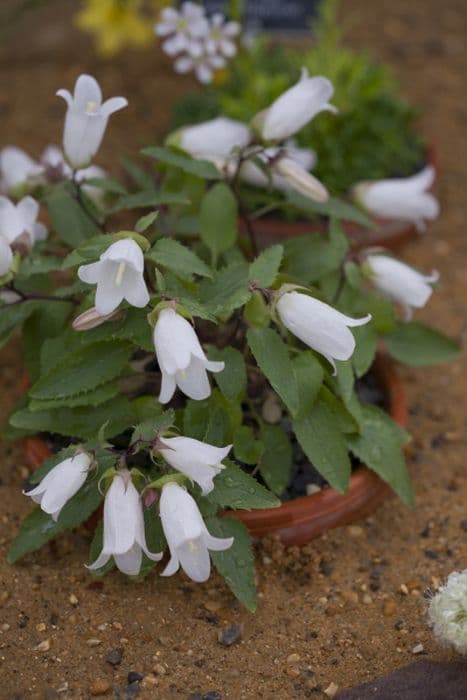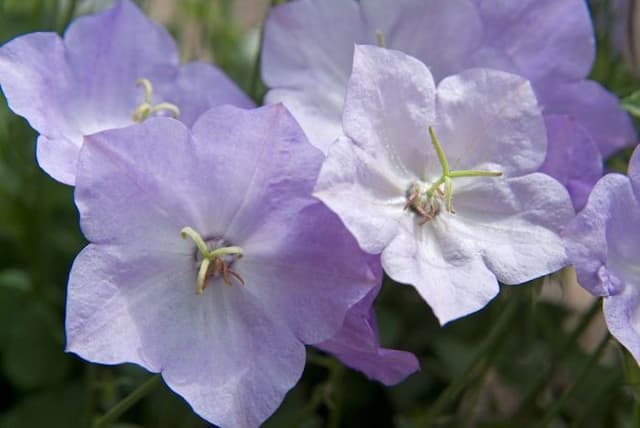Cardinal Flower Lobelia × speciosa 'Fan Tiefrot' (Fan Series)

ABOUT
Lobelia × speciosa 'Fan Tiefrot', commonly referred to as the Fan Scarlet Lobelia, presents a striking display with its deep red to burgundy flowers. These flowers are small and tubular with two lips, a characteristic feature of this plant type. The upper lip has two lobes, while the lower lip has three, creating a fan-like appearance. The blooms are densely packed on long, upright spikes, providing a showy floral display that can add drama and intensity to any garden setting. The foliage of Fan Scarlet Lobelia is typically lance-shaped with a slightly toothed edge. The leaves are often a dark green, which contrasts beautifully with the rich red blooms. Spread throughout the plant, the leaves grow in an alternate pattern along the stems, which may have a bushy habit. This plant exudes an overall lush and vibrant look with its combination of eye-catching flowers and full, green foliage, making it an attractive addition to flower beds, borders, and water features.
About this plant
 Names
NamesFamily
Campanulaceae
Synonyms
Cardinal Flower, Hybrid Lobelia
Common names
Lobelia × speciosa 'Fan Tiefrot'
 Toxicity
ToxicityTo humans
Lobelia, including the hybrid Lobelia × speciosa 'Fan Tiefrot' from the Fan Series, does contain alkaloids that can be toxic when ingested in large quantities. In humans, consuming parts of this plant can result in symptoms such as nausea, vomiting, diarrhea, cough, dizziness, convulsions, and in extreme cases, it could lead to respiratory failure and death. It is crucial to handle lobelia with care and ensure that it is not consumed by either adults or children.
To pets
Lobelia is similarly toxic to pets as it is to humans. Ingesting parts of the plant can cause symptoms such as vomiting, diarrhea, excessive salivation, lethargy, and possibly severe complications that could lead to difficulty breathing and convulsions. In extreme cases, consumption of lobelia may lead to fatal consequences. Pet owners should ensure that their animals do not have access to this plant to avoid accidental ingestion.
 Characteristics
CharacteristicsLife cycle
Perennials
Foliage type
Deciduous
Color of leaves
Green
Flower color
Red
Height
2-3 feet (60-90 cm)
Spread
1-2 feet (30-60 cm)
Plant type
Herb
Hardiness zones
4-9
Native area
North America
Benefits
 General Benefits
General Benefits- Attracts pollinators: The bright red flowers of Lobelia 'Fan Tiefrot' are attractive to bees and butterflies, which help in pollination.
- Adds color to gardens: Its vibrant red blossoms add a splash of color to garden landscapes and flower beds.
- Good for containers: Due to its compact size, it is well-suited for container gardening on patios or balconies.
- Long blooming period: It has a long flowering season, providing color from midsummer to early autumn.
- Low maintenance: Once established, it requires minimal care beyond regular watering and occasional fertilization.
- Drought tolerant: It is reasonably drought-tolerant, making it a good choice for gardens in drier climates.
- Deer resistant: The plant is not a preferred food source for deer, making it suitable for gardens in areas with deer populations.
 Medical Properties
Medical PropertiesThis plant is not used for medical purposes.
 Air-purifying Qualities
Air-purifying QualitiesThis plant is not specifically known for air purifying qualities.
 Other Uses
Other Uses- Lobelia 'Fan Tiefrot' can be used as a natural dye, offering hues of red or violet depending on the mordant used during the dyeing process.
- This plant is sometimes included in educational gardens to showcase examples of hybrid vigor and the benefits of selective breeding.
- Garden photographers may use the vibrant flowers of Lobelia 'Fan Tiefrot' as a stunning backdrop or focal point in garden photography.
- It can be used as an indicator plant, with its health reflecting the overall well-being of the garden, as it has moderate requirements for water and soil fertility.
- The flowers of Lobelia 'Fan Tiefrot' can be pressed and used in botanical art or herbarium collections for its striking coloration.
- Culinary artists may use the flowers for plating and presentation, adding visual appeal to dishes, though they are not edible.
- This plant's dense foliage can be used in creating miniature landscapes or fairy gardens by imaginative gardeners.
- Lobelia 'Fan Tiefrot' can be employed in companion planting to create color contrasts and complement the foliage of other plants in a mixed border.
- Garden designers may use this plant for thematic garden planning, such as a 'wine' themed garden due to its deep red flowers, resembling red wine hues.
- Its blooms may serve as an inspiration for artists and color designers, who can mimic the vivid reds in their works or fabric designs.
Interesting Facts
 Feng Shui
Feng ShuiThe Cardinal Flower is not used in Feng Shui practice.
 Zodiac Sign Compitability
Zodiac Sign CompitabilityThe Cardinal Flower is not used in astrology practice.
 Plant Symbolism
Plant Symbolism- Devotion: Lobelia often symbolizes devotion due to its perennial nature, returning each year with vibrant blooms, reflecting a steadfast commitment.
- Healing: Historically, lobelia was used in medicinal preparations, which is why it can carry the symbolism of healing and relief from ailments.
- Attraction: The striking color of 'Fan Tiefrot' can symbolize an attraction, whether it be in love, in friendships, or attracting good energies.
- Uniqueness: The Lobelia ‘Fan’ series, with its distinctive coloration and form, may represent the uniqueness and individual beauty of a person or situation.
- Communication: The bright flowers of the Lobelia are sometimes associated with an openness to communicate and the expression of thoughts and feelings.
 Water
WaterCardinal flowers, including 'Fan Tiefrot', prefer consistently moist soil, so water them deeply once every 1 to 3 days, depending on the weather conditions and soil drainage. During hot, dry periods, they may require daily watering, especially if planted in containers. Provide about 1 to 1.5 gallons of water per watering session for established plants in the ground, ensuring that the water penetrates deeply into the root zone. In containers, water until you see excess water draining from the bottom. During cooler or rainy periods, reduce the frequency to prevent waterlogging, which can lead to root rot.
 Light
LightCardinal flowers like 'Fan Tiefrot' require a spot that receives partial shade to full sun. They thrive best in areas that get morning sunlight and some afternoon shade, especially in hot climates. A location that shields them from intense midday sun helps prevent leaf scorch and keeps the colors of the blooms vibrant.
 Temperature
TemperatureCardinal flowers like 'Fan Tiefrot' do well in a range of temperatures and can survive minimum temperatures of approximately 20 to 50 degrees Fahrenheit. They thrive in warmer conditions with ideal growth occurring between 60 and 70 degrees Fahrenheit. However, they will not survive sustained temperatures over 90 degrees Fahrenheit without adequate shade and moisture.
 Pruning
PruningPrune cardinal flowers like 'Fan Tiefrot' to maintain their shape and promote bushier growth. Deadhead spent blooms regularly to encourage more flowers and prevent self-seeding if desired. Cut back the foliage to the ground in late fall or early winter after it has died back naturally.
 Cleaning
CleaningAs needed
 Soil
SoilCardinal Flower 'Fan Tiefrot' thrives in well-drained soil rich in organic matter, with a preferred pH of 6.0-7.0. Mix equal parts garden soil, peat moss, and perlite to achieve optimum conditions.
 Repotting
RepottingCardinal Flower 'Fan Tiefrot' does not require frequent repotting and can be done every 2-3 years or when root-bound.
 Humidity & Misting
Humidity & MistingCardinal Flower 'Fan Tiefrot' prefers moderate humidity levels, avoiding excessively dry or damp conditions.
 Suitable locations
Suitable locationsIndoor
Give bright light, ensure good air flow.
Outdoor
Plant in partial shade, shelter from wind.
Hardiness zone
4-9 USDA
 Life cycle
Life cycleLobelia × speciosa 'Fan Tiefrot', commonly known as Cardinal Flower, begins its life cycle with seed germination, which occurs in warm, moist soil conditions. From germination, the plant develops into a seedling with a small rosette of leaves at the soil surface. As it matures, the cardinal flower forms a larger clump with lance-shaped leaves and starts to develop sturdy flower stalks. During the blooming phase, usually in late summer, it produces tall spikes of deep red flowers that attract pollinators such as hummingbirds and butterflies. After pollination, the flowers develop into small capsules containing numerous tiny seeds. The plant dies back to the ground after flowering, completing its annual cycle, as it is usually treated as a perennial in cultivation, though some biennial behavior may occur depending on the climate and conditions.
 Propogation
PropogationPropogation time
Spring to Summer
The Lobelia × speciosa 'Fan Tiefrot', commonly known as the Cardinal Flower, is most commonly propagated through seed. To propagate Cardinal Flowers, seeds should be sown in late winter or early spring. They require light to germinate, so they should not be covered with soil, but rather gently pressed into the surface of a well-draining seed starting mix. The flats or trays must be kept in a warm place, around 70 degrees Fahrenheit (approximately 21 degrees Celsius), and maintain consistent moisture without becoming waterlogged. Germination typically takes 2 to 3 weeks. Once the seedlings have grown large enough to handle, they can be transplanted into individual pots and then eventually moved outdoors after the threat of frost has passed.









![Milky bellflower [Avalanche]](/_next/image?url=https%3A%2F%2Fplants-admin.emdemapps.com%2Fimages%2Fplants%2F%2Fimages%2F604b5dc88c1e7.png&w=640&q=75)